South Florida, and in particular, Miami-Dade County, has experienced a construction boom in the last decade which rivals that of any other big city nationally. The explosion of development has not slowed down and may actually be picking up, not only in terms of units but in terms of scope as well.
Indeed, the rest of the Sunshine State is also experiencing a tremendous uptick in development since the pandemic, especially the Tampa to Orlando corridor in Central Florida. At the same time, the construction industry has suffered from a labor shortage, which has been well documented by countless content pieces, articles, seminars and more over the years, with many industry members grappling with a declining quality and quantity of workers. The industry is now also bracing for the looming retirement of the baby boomer generation, a massive departure of the workforce that will require diligence and planning for the sector’s leaders to overcome.
Many of these concerns are heightened in South Florida, where some claim there is a potential for chaos simply because the market has more projects to build with less and less qualified help; surely a recipe for delays, defects, liens, litigation, foreclosures and bankruptcies alike. It remains true that the same mistakes and oversights that led to those problems ten years ago will continue to cause problems for businesses now, whether short-staffed, over-staffed or all stages between. Drowning out that industry noise is critical to a successful operation and project.
Contract Considerations and Negotiations
All construction projects involve the same fundamentals of cost, time and scope. In a world where more and more processes are becoming automated, with a number of employees bidding upon and negotiating projects at all times, it is likely for executives to forget about another universal, fundamental element associated with each and every construction project: the parties’ relationship.
Sales training usually preaches selling on value while emphasizing the need to establish trust and confidence with your customer so he or she believes that the job will be done competently and with integrity, which dovetails into making things right if and when they go wrong. More times than not, that relationship and trust will win the job.
Accordingly, any executive team should have the ability to assess its current workforce in conjunction with the needs for a specific project in terms of scope, cost and time, and to bid, plan and negotiate a construction agreement with that assessment in mind. The ideal place to start is one in which the current workforce’s ability to competently deliver the project on time and under budget is not in question, while considering factors outside of the workforce’s control. There is no reason for a company to over-promise and under-deliver or to have to cut corners throughout the project, thereby jeopardizing its relationship with the customer and increasing its risk exposure in a multitude of areas, i.e., workmanship, delays, non-payment, change-order disputes, bond claims, etc.
Every construction agreement and negotiation allows for these considerations. All contractors should a schedule they feel comfortable with. If an owner or developer has a tighter schedule in mind, that merits discussion regarding potential adjustments to items such as cost, fee, general conditions, liquidated damages and early completion bonuses in addition to the schedule.
Likewise, the optimal payment structure is another item that should be evaluated after assessing your workforce and project deliverables. Perhaps a stipulated sum is most sensible, rather than a cost-plus fee agreement for a particular project.
Moreover, if working with a cost-plus contract, a guaranteed maximum price is a worthwhile consideration and not just one that reflects the project budget, which happens with alarming frequency, but one that reflects potential delays, scope or design changes, workforce issues, price increases, etc. Far too often companies shy away from the comfort of a proverbial ceiling on cost, which of course can be adjusted. Even worse, when providing a GMP, contractors often fail to give themselves the space—and time—needed for a successful project and relationship from start to finish.
This race-to-the-bottom mentality is the exact opposite of transparent, relationship-focused dealings. The latter encourages collaboration between the ownership, design and construction teams as early on in a project as possible, including potential alternative project-delivery methods such as integrated project delivery.
Such initial efforts will further bolster the relationship by way of providing an even clearer understanding of the specific project fundamentals while factoring in potential impacts due to a company’s current and potential workforce.
Quality over quantity Control
The same mindset needs to be in place to ensure quality control over a project, regardless of workforce status. Executives must strive to assess gaps in their workforce now to then be able to negotiate around those gaps later, all the while creating processes to fill those gaps throughout a project.
scrutinize and recruit
Those working in or with the construction industry are well aware of the worsening labor shortage not only because of overwhelming statistics but because they are seeing and experiencing the signs first-hand. That is why company leadership requires just as much scrutiny as global economics, generational transitions or pandemics. Transparency is critical for a flourishing workforce, and the leaders that clearly communicate how they are tackling these industry issues and defining their company’s future are setting themselves up for success. Any CEO, executive or employee should care about their organization’s answers to the challenges they face and push to lift the curtain on their business’s operations and potential future. Most people, regardless of generation, want to work for a company that cares about its future and continuously strives to evolve.
Each and every construction industry executive has to assess its workforce status along with its company’s potential needs both short- and long-term. Current and future projects should be carefully planned and negotiated based upon that assessment. Moreover, if not already in place, the executive team must immediately establish its processes and goals for recruiting, training and promoting talent for the next decade and beyond. Having a management team in place that drowns out the noise, does not overreact or panic, and implements such initiatives will provide the strongest foundation for long-term success of the business.







